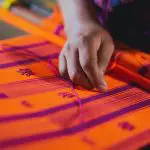When it comes to fabric printing, the age-old question persists: 'Is screen print truly the champion, or does heat transfer reign supreme?'
Delving into the realm of fabric printing methods, you seek to master the nuances that set these techniques apart.
Examining factors such as durability, cost, quality, intricacy of design, production speed, environmental impact, and application versatility, you aim to discern which method holds the superior position.
With a balanced and objective approach, you will explore the intricacies of both screen printing and heat transfer, gaining a comprehensive understanding of their respective strengths and limitations.
Key Takeaways
- Screen printing offers superior durability and longevity compared to heat transfer.
- Screen printing generally results in lower per-unit costs for larger orders, making it a wiser long-term investment for businesses.
- Both screen printing and heat transfer can achieve high color vibrancy and detail, but screen printing is known for capturing finer details and intricate patterns.
- Screen printing is versatile for various fabric types, while heat transfer may have limitations based on fabric type and texture.
Durability Comparison
When comparing the durability of screen print and heat transfer, you'll find that screen printing generally offers superior longevity and resistance to fading and wear.
Screen printing tends to have better material resilience, making it more resistant to wear and tear compared to heat transfer. This method involves pushing ink through a fine mesh screen onto the fabric, resulting in a more durable and long-lasting print. The ink used in screen printing is designed to withstand repeated washing and prolonged use without losing its color vibrancy or sharpness.
On the other hand, heat transfer, while offering versatility and intricate details, may not hold up as well to frequent washing and prolonged use. The heat-applied designs are prone to cracking and peeling over time, especially when subjected to rigorous washing and extensive wear.
Therefore, when prioritizing fabric endurance and seeking a printing method that stands the test of time, screen printing proves to be the more durable choice.
Cost Analysis
Comparing the cost of screen printing and heat transfer, you'll find that screen printing generally results in lower per-unit costs due to its higher durability and long-term wear resistance. While heat transfer may seem more cost-effective for small orders due to lower initial setup costs, screen printing becomes the more cost-effective option for larger orders due to economies of scale. When considering the long term investment, screen printing proves to be more advantageous as its prints are more resistant to fading, cracking, and peeling, ensuring a longer lifespan for the product. The table below illustrates a cost comparison between screen printing and heat transfer for different order quantities.
| Order Quantity | Screen Printing Cost | Heat Transfer Cost |
|---|---|---|
| 50 | $X | $Y |
| 100 | $A | $B |
| 500 | $C | $D |
| 1000 | $E | $F |
The table clearly demonstrates that as the order quantity increases, the cost effectiveness of screen printing becomes more apparent, making it a wiser long-term investment for businesses.
Quality Assessment
When evaluating fabric printing methods, it's essential to consider durability and washability. These two points are crucial in determining the overall quality and longevity of the printed design. By assessing these factors, you can make an informed decision about which printing method best meets your specific needs.
Another important aspect to consider is color vibrancy. The ability of the printing method to produce vibrant and true-to-life colors can greatly enhance the visual impact of the printed fabric. This is particularly important if you are looking to create eye-catching designs or patterns.
Additionally, the level of detail that can be achieved through the printing method should be taken into account. Some methods may be better suited for intricate and highly detailed designs, while others may be more suitable for simpler patterns or larger graphics.
Durability and Washability
Assessing the durability and washability of fabric prints is crucial to determine their longevity and maintenance requirements. When comparing fabric printing methods, several key factors need to be considered in the durability and washability assessment.
- Color Fastness: Evaluating how well the colors withstand multiple washes without fading or bleeding.
- Fabric Reaction: Considering how the fabric and print interact during washing to ensure the print remains intact.
- Abrasion Resistance: Assessing the print's ability to withstand friction and wear over time.
- Cleaning Method: Determining the specific washing and drying instructions to maintain the print's quality.
Color Vibrancy and Detail
To determine the superiority of screen print or heat transfer for fabric printing, examine the color vibrancy and detail achieved by each method. Color fastness and image resolution are crucial elements to consider when evaluating the quality of fabric printing methods. Both screen printing and heat transfer can achieve high color vibrancy and detail, but there are differences in the methods used to achieve these results. Below is a comparison table to help you visualize the differences in color vibrancy and detail between screen print and heat transfer methods.
| Quality Aspect | Screen Print | Heat Transfer |
|---|---|---|
| Color Vibrancy | High | High |
| Detail Resolution | Excellent | Good |
| Longevity | Good | Good |
Consider your specific needs for color vibrancy and detail when choosing between screen print and heat transfer methods.
Design Intricacy
When deciding between screen printing and heat transfer for fabric printing, it's important to consider the intricacy of your design.
Screen printing is known for its ability to capture fine details and intricate patterns, making it a suitable choice for designs with a high level of complexity.
On the other hand, heat transfer can also handle detailed designs, but it may have limitations when it comes to extremely intricate patterns.
Design Detail Comparison
You can achieve finer design intricacy with screen printing due to its ability to capture intricate details more accurately than heat transfer. Screen printing offers superior design complexity and printing accuracy compared to heat transfer, making it the preferred method for intricate designs.
This is due to the following reasons:
- Screen printing allows for finer lines and smaller details to be accurately reproduced on fabric.
- The ink used in screen printing is able to create more intricate and detailed designs with precision.
- Screen printing provides a wider range of color options, allowing for intricate designs with multiple shades and gradients.
- The level of control and precision in screen printing enables the reproduction of complex and detailed patterns with accuracy and clarity.
Intricate Pattern Suitability
With its ability to capture intricate details more accurately than heat transfer, screen printing remains the preferable method for intricate designs, especially when it comes to intricate pattern suitability. Screen print technology allows for the reproduction of intricate patterns with high precision and detail, making it ideal for designs with fine lines, small text, and complex artwork. Its versatility in handling intricate patterns makes it a favored choice for designers looking to express detailed and elaborate designs on fabric. On the other hand, heat press suitability for intricate patterns is limited due to potential loss of detail and clarity. When it comes to intricate pattern suitability, the advantages of screen printing are evident.
| Screen Print | Heat Transfer |
|---|---|
| High precision and detail | Limited detail retention |
| Versatility in handling intricate patterns | Potential loss of detail and clarity |
| Ideal for fine lines, small text, and complex artwork | Limited suitability for intricate designs |
Production Speed
For most fabric printing projects, screen printing offers a faster production speed compared to heat transfer methods. Screen printing allows for efficient production due to several factors:
- Equipment investment: Screen printing involves the use of specialized screens and squeegees, which allows for high-speed and large-scale production once the initial setup is complete.
- Labor efficiency: Once the screens are prepared, the actual printing process is relatively quick, making it efficient in terms of labor and time.
- Consistency: Screen printing can maintain consistent quality and speed across large print runs, ensuring uniformity in the final product.
- Drying time: In screen printing, the drying process is typically faster, allowing for quicker turnaround times compared to heat transfer methods.
These factors contribute to the overall faster production speed of screen printing, making it the preferred choice for projects that require rapid and large-scale fabric printing. However, it's essential to consider the specific requirements of each project to determine the most suitable method for achieving the desired outcome within the required timeframe.
Environmental Impact
Transitioning from the discussion of production speed, it's important to consider the environmental impact of both fabric printing methods. When comparing screen printing and heat transfer, it's essential to evaluate their carbon footprint.
Screen printing generally involves more manual labor and the use of more chemicals, leading to a potentially higher carbon footprint compared to heat transfer. On the other hand, heat transfer can produce more waste due to the release liner used in the process.
In terms of eco-friendly alternatives, both methods have their own challenges. Screen printing requires careful management of chemicals and proper disposal to minimize environmental impact. On the other hand, heat transfer often involves plastic-based materials, which can be detrimental to the environment if not managed properly. However, advancements in eco-friendly ink formulations and the use of recycled materials in heat transfer have made it a more sustainable option.
Ultimately, when considering the environmental impact, it's essential to weigh the carbon footprint and waste generation of each method, while also exploring eco-friendly alternatives such as water-based inks and recycled materials to minimize the environmental impact of fabric printing.
Application Versatility
Considering the previous subtopic's discussion on environmental impact, it's important to evaluate each method's application versatility. When comparing screen printing and heat transfer, it's crucial to understand their respective application flexibility to determine which method best suits your needs. Here's a comparison of their application versatility:
- Fabric Type: Screen printing is more versatile when it comes to fabric types, as it can be applied to a wide range of materials including cotton, polyester, and blends. On the other hand, heat transfer may have limitations depending on the fabric type and texture.
- Detail and Color Complexity: Screen printing is known for its ability to reproduce intricate designs and vibrant colors, making it ideal for complex artwork. Heat transfer, while capable of producing detailed designs, may have limitations with color vibrancy and intricate details.
- Small Batch vs. Large Production: Heat transfer is often more suitable for small batch productions due to its ease of customization, while screen printing excels in larger production runs where cost per unit decreases.
- Special Effects: Heat transfer allows for a variety of special effects such as metallic finishes and foil applications, offering more versatility in creating unique and eye-catching designs. Screen printing, while versatile, may have limitations in achieving certain special effects.
Understanding these application versatility differences can help you make an informed decision based on your specific printing needs.
Frequently Asked Questions
Can Screen Printing or Heat Transfer Withstand Frequent Washing and Wear?
With frequent washing and wear, both screen printing and heat transfer can withstand the test of durability. Proper maintenance is key to ensuring longevity and quality for both methods, making them suitable for your needs.
How Do the Initial Costs of Equipment and Materials Compare Between Screen Printing and Heat Transfer?
When comparing initial investment, screen printing requires more equipment and set-up costs, while heat transfer has lower initial costs. Long term costs depend on volume and complexity of designs, with screen printing often more economical.
Are There Any Differences in Color Vibrancy and Detail Between Screen Printing and Heat Transfer?
In fabric printing, screen print offers superior color vibrancy and detail precision, while heat transfer excels in durability and production speed. Both methods have their strengths, so it's important to assess your specific needs before choosing.
Can Intricate Designs With Fine Details Be Achieved With Both Screen Printing and Heat Transfer Methods?
Yes, both screen print and heat transfer methods can achieve intricate designs with fine details. Screen print precision allows for sharp lines and vivid colors, while heat transfer intricacy offers the ability to capture subtle nuances in designs.
Are There Any Differences in the Time It Takes to Complete a Printing Job Using Screen Printing Versus Heat Transfer?
When comparing printing speed, screen printing is faster than heat transfer, but heat transfer offers high quality. Screen printing has long-term durability, while heat transfer requires minimal maintenance. Both methods have their strengths and considerations.
- Does Linen Keep You Cool at Night? - April 9, 2024
- Is Linen Cool for Sleeping? - April 9, 2024
- Is Linen Sun Proof? - April 9, 2024





